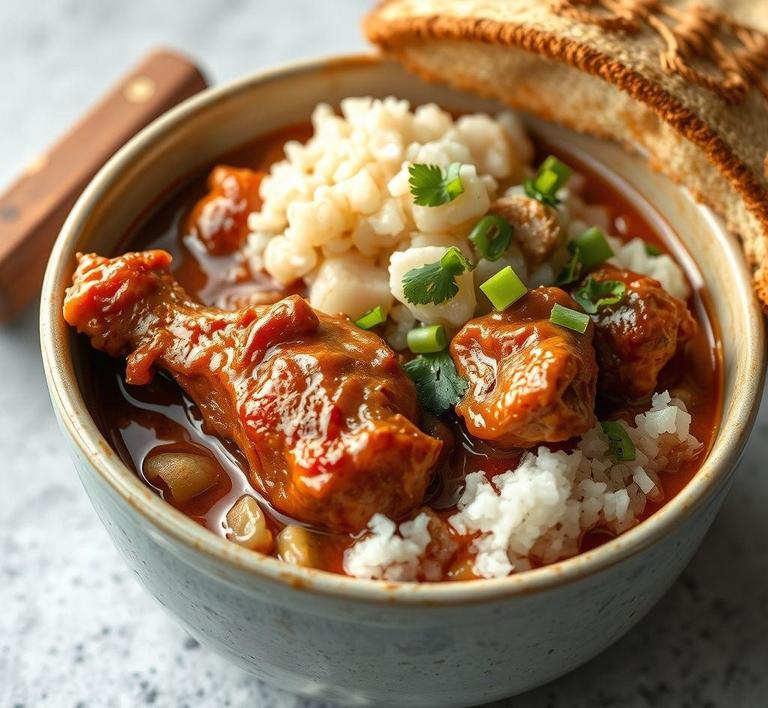So, you’re wondering if you can refreeze chicken gumbo? Well, you’re not alone! It’s a common question, especially when you’ve made a big batch of this savory, flavorful dish and have some leftovers. Refreezing chicken gumbo can be a bit tricky, but it’s definitely doable with the right approach. The key is to understand the basics of freezing and thawing, and how to preserve the texture and taste of the gumbo while keeping it safe to eat. In this guide, we’ll walk you through everything you need to know about refreezing chicken gumbo, from how to store it properly to tips for reheating so you can enjoy your gumbo just like it was freshly made!
Can You Refreeze Chicken Gumbo?

The short answer is yes, you can refreeze chicken gumbo, but it’s not always the best idea unless you’re really careful about how you go about it. Refreezing food, in general, introduces some safety and quality concerns, and chicken gumbo is no exception. Let’s explore the reasons why:
-
Food Safety Concerns:
When chicken gumbo is first frozen, it’s typically safe as long as it hasn’t been left out too long during the thawing process. However, each time it’s thawed and then refrozen, you’re allowing the potential growth of bacteria that might not have been fully killed during the initial cooking or freezing process. This could lead to foodborne illnesses if not handled properly. The USDA recommends that food should not be refrozen after it’s been thawed, especially if it’s been sitting out for more than 2 hours.
-
Texture and Quality Issues:
Gumbo is a stew, and a key characteristic of its allure is the rich, thick, and sometimes slightly silky texture of the broth, which is usually made with a roux (flour and fat) and various seasonings. Refreezing can disrupt the texture. The gumbo’s thickened base may break down during the thawing and refreezing process, leading to a soupy, watery consistency. The chicken and other ingredients might lose their tenderness, becoming tough or rubbery, which significantly affects the dish’s mouthfeel.
-
Nutritional Degradation:
With repeated freezing and thawing, some of the nutrients-particularly those in vegetables and herbs-can degrade. While this might not render the dish unsafe, it can diminish its overall nutritional value and flavor profile.
In conclusion, while you can refreeze chicken gumbo, it’s not always the most ideal choice, especially if you care about maintaining the dish’s safety, texture, and flavor integrity. If you do choose to refreeze it, be sure to follow the best practices to reduce the risks involved.
How To Refreeze Chicken Gumbo?
If you’ve made the decision to go ahead and refreeze your chicken gumbo, it’s essential to do so properly to minimize any potential issues. Here’s a step-by-step guide on how to ensure you’re doing it as safely and efficiently as possible:
-
Cool Down the Gumbo Properly:
The first step is to make sure your gumbo is cooled quickly after it has been initially thawed and cooked. Bacteria thrive in the temperature range between 40°F and 140°F, so it’s crucial to cool the gumbo down to a safe temperature (below 40°F) as fast as possible. One way to do this is by placing the gumbo in shallow containers and putting them in the fridge. You could also stir the gumbo occasionally to help release heat.
-
Separate into Smaller Portions:
If you have a large batch of gumbo, dividing it into smaller, airtight containers will help it freeze and thaw more evenly. This is not only a safer practice but also allows you to thaw only what you need rather than the entire batch. Smaller portions reduce the amount of time it spends in the ‘danger zone’ temperatures during thawing.
-
Use Airtight Containers or Freezer Bags:
To preserve the quality of your gumbo as much as possible, store it in airtight containers or heavy-duty freezer bags. When using bags, squeeze out as much air as possible to prevent freezer burn, which can lead to an unpleasant taste and texture. If using containers, ensure they are sealed tightly and labeled with the date to track how long it’s been frozen.
-
Freeze Quickly:
Once the gumbo is packed away, place it in the freezer as quickly as possible to minimize any issues with ice crystals. The quicker it freezes, the less time bacteria have to multiply or the texture to degrade. If you have a deep freezer, use that instead of a regular freezer because deep freezers maintain a more consistent, lower temperature.
-
Limit the Number of Refreezing Cycles:
Refreezing chicken gumbo more than once should be avoided if possible. Each cycle introduces more chances for bacterial growth and greater deterioration of the gumbo’s texture and flavor. Ideally, you should aim to eat or use up the gumbo within 3 to 4 months to ensure it remains safe and tasty.
-
Thaw Safely:
To minimize bacterial growth and preserve the texture, it’s best to thaw the refrozen gumbo in the refrigerator rather than on the counter. This will allow it to thaw slowly and safely. Avoid using a microwave for thawing, as it can heat unevenly, which may not only leave parts of the gumbo unsafe but can also change its texture.
Quality Impact Of Refreezing Chicken Gumbo
When it comes to the quality of chicken gumbo after refreezing, several factors come into play. While you can technically refreeze it, the resulting dish may not be as vibrant, rich, or fresh as it was before.
-
Texture Changes:
The most noticeable impact of refreezing chicken gumbo is usually on its texture. Gumbo relies on its sauce being thick and rich, and this is often achieved with a roux (a flour and fat mixture). Repeated freezing and thawing cause the roux to break down and lose its creaminess, making the gumbo more watery. Additionally, the chicken, vegetables, and any other ingredients can become mushy or tough due to the freezing process, altering the overall mouthfeel of the dish.
-
Flavor Deterioration:
Refreezing chicken gumbo can also result in a loss of flavor intensity. The spices, herbs, and other seasoning elements may become less vibrant. Even the chicken itself can lose some of its taste, especially if it’s thawed and reheated multiple times. While gumbo may still be edible, the complex, comforting flavors of the initial dish may fade, leaving it bland or less satisfying.
-
Separation of Ingredients:
As gumbo is frozen and thawed, the various ingredients can begin to separate. The broth and fat can separate from the solids, causing an unappetizing look and a change in texture. While some separation is normal when freezing liquids, in a gumbo, this can result in a greasy surface or uneven consistency when reheated.
-
Nutritional Degradation:
The nutritional content of chicken gumbo may degrade slightly with each freezing cycle. Vegetables lose some of their vitamins and minerals when exposed to freezing temperatures, especially with long storage times. Although this won’t make your gumbo unsafe to eat, it could reduce the overall health benefits of the dish.
While it’s possible to refreeze chicken gumbo, it’s a process that comes with risks, both in terms of food safety and quality. The key points to remember are:
- Food Safety: Only refreeze gumbo if it has been handled and stored properly, and avoid refreezing if the gumbo has been left out at room temperature for more than 2 hours.
- Quality Impact: Expect changes in texture, flavor, and appearance, as repeated freezing and thawing will degrade the gumbo’s consistency and taste. Chicken and vegetables can become tough or mushy, and the broth can become watery.
- Best Practices: If you choose to refreeze chicken gumbo, ensure it’s cooled quickly, stored in airtight containers, and refrozen in smaller portions. Also, limit the number of times it is refrozen to preserve its quality.
If you’re looking to enjoy chicken gumbo at its best, it’s always preferable to freeze it only once and use it as soon as possible after it’s thawed. While refreezing can be a convenient way to extend the shelf life of your dish, be aware of the trade-offs in terms of quality and safety. With careful handling, you can still enjoy a decent version of your gumbo even after refreezing, but the fresh, flavorful experience of the original dish is hard to replicate!
Is It Safe To Refreeze Chicken Gumbo?
Chicken gumbo, with its hearty mix of tender chicken, vegetables, spices, and rich broth, is a beloved comfort food. But when it comes to storing and refreezing leftovers, you might find yourself wondering: is it safe to refreeze chicken gumbo?
The answer largely depends on how the gumbo has been handled and how many times it has been frozen and thawed.
In theory, refreezing chicken gumbo is possible, but there are some critical factors to keep in mind. The safety of refreezing is mainly determined by how the gumbo was initially cooked, cooled, and stored. If the gumbo was thawed in the fridge and hasn’t been sitting out for extended periods, it can be refrozen with minimal risk. However, if it was left at room temperature for several hours, bacteria may have had the chance to multiply, and refreezing could result in foodborne illness.
The key to safely refreezing chicken gumbo lies in its initial handling. If you cooked the gumbo and froze it right away, it’s best to thaw it in the refrigerator, then only refreeze if you’re certain it hasn’t been sitting out too long. Always use a thermometer to ensure the gumbo is at least at 165°F (74°C) when reheating, as this will kill any potential harmful bacteria.
In short, while it’s possible to refreeze chicken gumbo, you should only do so if the gumbo has been stored and handled correctly. Avoid any guesswork when it comes to food safety.
Signs That Chicken Gumbo Should Not Be Refrozen
There are a few clear signs that your chicken gumbo has gone past the point of safe refreezing. Recognizing these will help you avoid eating something that could lead to illness:
- Unpleasant Smell: One of the most immediate indicators that your gumbo should not be refrozen is an off-putting or sour smell. If it smells anything like spoiled meat or has a rotten odor, it’s a clear sign of bacterial growth, and you should discard it immediately.
- Visible Mold or Discoloration: Any change in color, such as the gumbo turning an unusual brown or greenish hue, can indicate that it has spoiled. Similarly, the appearance of mold on the surface means that bacteria or fungi have started to grow, and refreezing should definitely be avoided.
- Slimy Texture: If the gumbo has a slimy or gooey texture that wasn’t there when it was first made, it’s a sign of bacterial activity. This can happen if it was improperly stored or if it was thawed and left at room temperature for too long.
- Improper Storage Conditions: If you’ve noticed that the gumbo has been thawed for over two hours at room temperature, or if it was kept in an area above 40°F (4°C) for an extended period, it may no longer be safe to refreeze. Bacteria like Salmonella or E. coli can thrive in such conditions, and refreezing would only trap harmful bacteria in the food.
- Change in Consistency: Gumbo is known for its rich and somewhat thick consistency, but when frozen and thawed improperly, the texture can change dramatically. If the gumbo has turned watery or the meat has become stringy or rubbery, it might not only be unsafe to refreeze, but it’s likely to taste unappetizing as well.
Common Refreezing Mistakes
Refreezing gumbo can lead to a poor experience or, worse, foodborne illness if not done correctly. Here are some common mistakes that should be avoided:
- Refreezing After Multiple Thaw Cycles: One of the biggest mistakes people make is repeatedly thawing and refreezing gumbo. Each time food is thawed and then refrozen, it loses quality, and the chance of bacterial growth increases. If you must refreeze gumbo, try to limit it to one cycle, and never refreeze food that’s been thawed multiple times.
- Not Cooling Gumbo Properly Before Freezing: Before putting chicken gumbo in the freezer, it’s essential to cool it to room temperature. Placing hot gumbo straight into the freezer can cause ice crystals to form, leading to freezer burn, and it may also raise the temperature of the freezer, which can compromise the quality of other frozen food.
- Freezing in Large Portions: While it may seem efficient to freeze large quantities of gumbo in one big batch, it can be difficult to thaw large amounts evenly. This can result in uneven temperatures when reheating and increase the risk of bacterial growth. It’s better to freeze gumbo in smaller portions, so you can defrost just what you need.
- Using Improper Containers: Freezer bags and airtight containers are essential when freezing gumbo to preserve its flavor and texture. If you use containers that aren’t properly sealed, the gumbo can absorb odors from other items in the freezer, or worse, it can suffer from freezer burn, making it dry and unappetizing. Avoid using regular plastic wrap or containers that don’t seal tightly.
- Not Labeling the Gumbo: Another mistake many make is failing to label their gumbo before freezing it. Without a date or description, you won’t know how long it’s been in the freezer or if it’s still safe to consume. Always label and date your containers to keep track of storage time.
Tips And Tricks
To ensure that your chicken gumbo stays delicious and safe after refreezing, follow these helpful tips and tricks:
- Freeze in Portions: When freezing gumbo, divide it into meal-sized portions. This way, you can thaw only what you need and avoid unnecessary refreezing. Small portions also cool faster and freeze more evenly.
- Use Vacuum Sealing: If you have a vacuum sealer, use it for extra protection. Vacuum-sealed bags remove air and prevent freezer burn, preserving the flavor and texture of your gumbo much better than traditional freezer bags.
- Cool Before Freezing: Allow your gumbo to cool completely to room temperature before freezing. You can speed up this process by placing the gumbo in shallow containers to promote faster cooling. This also helps to avoid a temperature spike in your freezer.
- Reheat Slowly: When you’re ready to eat your gumbo, avoid reheating it in a microwave as it can make the texture rubbery and uneven. Instead, heat it gently on the stove over medium heat, stirring frequently to ensure it heats evenly.
- Add Freshness When Reheating: Gumbo can sometimes lose its freshness when frozen. When reheating, consider adding a splash of fresh stock or a squeeze of lemon juice to brighten the flavor. You can also add fresh parsley or green onions to restore some of the vibrant flavor.
Conclusion
In conclusion, while it is possible to refreeze chicken gumbo, it should only be done with careful consideration of food safety practices. Proper cooling, storing, and reheating are essential to preserve both the safety and quality of the gumbo. Refreezing should be limited to one cycle, and you should always check for signs of spoilage before considering a second freeze.
By avoiding common mistakes, like improper storage or repeatedly freezing and thawing, you can enjoy your gumbo later without compromising its flavor or risking your health. So, while it’s not always ideal to refreeze chicken gumbo, with the right precautions, you can extend its shelf life and reduce waste, all while keeping it safe and tasty.


